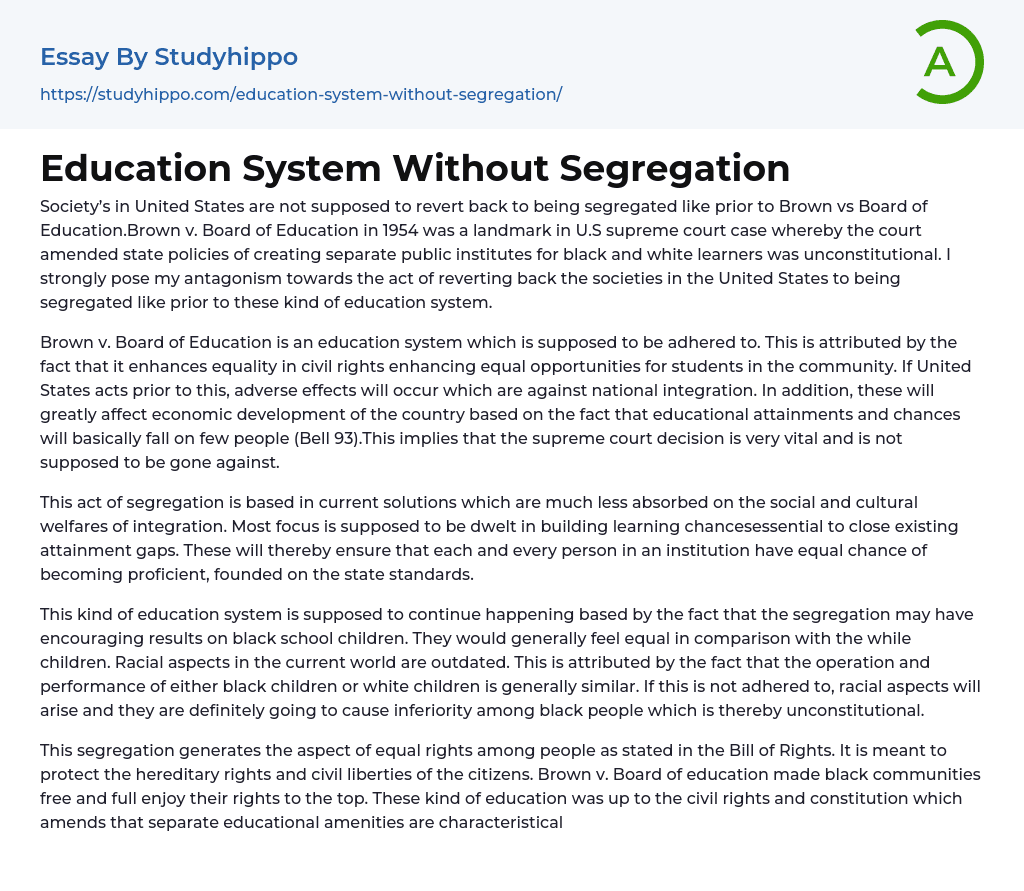I strongly oppose any efforts to reintroduce pre-Brown vs. Board of Education segregation in American society. The 1954 Supreme Court ruling deemed state policies allowing racially segregated public schools unconstitutional, and it is vital that we refrain from returning to such divisive practices.
Brown v. Board of Education is a vital educational system that should be adhered to as it advocates for civil rights equality and offers students equal opportunities, ultimately fostering community integration. Counteracting this in the United States would result in adverse effects and contradict national integration.
It is crucial to acknowledge that the impact of these factors on the country's economic development cannot be underestimated. Access to education and opportunities will primarily be limited to a select group of individuals (Bell 93). Hence, it is imperative to respect and adhere to decisions made by the supreme cou
...rt in order to address this issue. The current segregation stems from solutions that do not prioritize the social and cultural benefits of integration. Efforts should concentrate on creating educational opportunities that bridge existing achievement gaps, ensuring equal chances for all individuals within an institution to excel based on state standards.
This education system is expected to persist because segregation may have positive effects on black school children. They would typically feel equal compared to white children. Racial considerations in today's society are outmoded due to the similar functioning and achievement of both black children and white children.
If racial aspects are not followed, it will result in the emergence of inferiority among black people, which is unconstitutional. This segregation promotes equal rights among individuals, as stated in the Bill of Rights. It aims to safeguard the inherited right
and civil liberties of citizens. Brown v.
The Board of Education made sure that black communities were provided with the same educational opportunities as others, in accordance with civil rights and constitutional amendments. These measures aimed to tackle the inequality associated with segregated schools and offer fair opportunities for academic achievement. However, there is an urgent requirement for additional measures to cater to impoverished communities and the declining middle class. Currently, schools that contribute to the nation's economic goals are of great importance.
In his argument, Horowitz (13) stresses the importance of providing support to students, their families, and society as a whole. This essential step should be based on the foundational principles of family, society, and economic progress. The Segregation Act highlights the significance of these fundamental components for the successful operation of the state. In conclusion, returning to the period before Brown v. Board of Education in the United States could lead to significant negative outcomes.
The case of Brown v. Board of Education is a significant landmark in the education system because it advocates for equality among all individuals, stressing the importance of providing every child with equal opportunities to receive a quality education. It strongly argues against returning to the era of segregation that existed prior to this case.
Work cited
- Bell Jr, Derrick A. "Brown v. Board of Education and the interest-convergence dilemma." Harv. L. Rev.
The article "93 (1979): 518" by Patterson, James T., and William W. Freehling examines the significant achievement in civil rights known as Brown v. Board of Education and its complex aftermath.The text contains citations from various sources, including the following:
1. Oxford University Press, 2001.
2. Dixson, Adrienne D., and
Celia K. Rousseau's article titled "And we are still not saved: Critical race theory in education ten years later," published in Race ethnicity and education journal in 2005 (Volume:8 Issue:1 Page range:7-27).
3. Horowitz, Harold W.'s article titled "Unseparate but unequal-The emerging fourteenth amendment issue in public school education," published in UCLA L.Rev. journal in 1965 (Volume:13 Page range:1147).
4. Orfield, Gary's work with Susan E.
These citations include information about the authors and publication details enclosed within .
E. Eaton's book, "Dismantling desegregation: The quiet reversal of Brown v. Board of Education" was published by The New Press in 1997.
- Academia essays
- Academic And Career Goals essays
- Academic Integrity essays
- Brainstorming essays
- Brown V Board of Education essays
- Brown Vs Board Of Education essays
- Coursework essays
- Curriculum essays
- Distance learning essays
- Early Childhood Education essays
- Education System essays
- Educational Goals essays
- First Day of School essays
- Higher Education essays
- Importance Of College Education essays
- Importance of Education essays
- Language Learning essays
- Online Education Vs Traditional Education essays
- Pedagogy essays
- Philosophy of Education essays
- Purpose of Education essays
- Scholarship essays
- Study essays
- Studying Abroad essays
- Studying Business essays
- Technology in Education essays
- The Importance Of Higher Education essays
- Vocabulary essays
- Writing Experience essays
- Antisemitism essays
- Black History Month essays
- Black Lives Matter essays
- I Have a Dream essays
- Ku Klux Klan essays
- Malcolm X essays
- Martin Luther King essays
- Miscegenation essays
- Racial Inequality essays
- Racial Segregation essays




